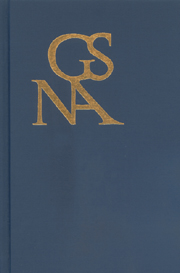Book contents
- Frontmatter
- Contents
- Special Section on Goethe and Idealism
- Introduction—Goethe and Idealism: Points of Intersection
- Goethe and Spinoza: A Reconsideration
- Goethean Intuitions
- Goethe's Notion of an Intuitive Power of Judgment
- “Idealism is nothing but genuine empiricism”: Novalis, Goethe, and the Ideal of Romantic Science
- The Quest for the Seeds of Eternal Growth: Goethe and Humboldt's Presentation of Nature
- Hegel's Faust
- Goethe contra Hegel: The Question of the End of Art
- Goethean Morphology, Hegelian Science: Affinities and Transformations
- Die Gretchenfrage: Goethe and Philosophies of Religion around 1800
- Civic Attachments & Sibling Attractions: The Shadows of Fraternity
- Margarete-Ariadne: Faust's Labyrinth
- Save the Prinz: Schiller's Geisterseher and the Lure of Entertainment
- Walsers Trilogie der Leidenschaft: Eine Analyse seines Goethe-Romans Ein liebender Mann im Kontext der Tradition der Ulrike-Romane
- Review Essay: What's New in the New Economic Criticism
- Book Reviews
Goethean Morphology, Hegelian Science: Affinities and Transformations
from Special Section on Goethe and Idealism
Published online by Cambridge University Press: 05 February 2013
- Frontmatter
- Contents
- Special Section on Goethe and Idealism
- Introduction—Goethe and Idealism: Points of Intersection
- Goethe and Spinoza: A Reconsideration
- Goethean Intuitions
- Goethe's Notion of an Intuitive Power of Judgment
- “Idealism is nothing but genuine empiricism”: Novalis, Goethe, and the Ideal of Romantic Science
- The Quest for the Seeds of Eternal Growth: Goethe and Humboldt's Presentation of Nature
- Hegel's Faust
- Goethe contra Hegel: The Question of the End of Art
- Goethean Morphology, Hegelian Science: Affinities and Transformations
- Die Gretchenfrage: Goethe and Philosophies of Religion around 1800
- Civic Attachments & Sibling Attractions: The Shadows of Fraternity
- Margarete-Ariadne: Faust's Labyrinth
- Save the Prinz: Schiller's Geisterseher and the Lure of Entertainment
- Walsers Trilogie der Leidenschaft: Eine Analyse seines Goethe-Romans Ein liebender Mann im Kontext der Tradition der Ulrike-Romane
- Review Essay: What's New in the New Economic Criticism
- Book Reviews
Summary
GOETHE'S CONCEPTION OF MORPHOLOGY had a major impact on Hegel's philosophical methodology at a point in time when Hegel was beginning to distance himself from Schelling and to confront dead-ends in his own previous conception. In 1803, Schelling left Jena to accept a chair in Würzburg, thus effectively ending the symphilosophical partnership that formed the element of Hegel's first years at the university. At about this time, Hegel must have begun to question the viability of Schellingian “intellectual intuition” as a mode of philosophical cognition, and to have doubts whether his own conception of a “skeptical” logic was sufficient to justify it via negationis. Up to this point, Hegel had proposed that a methodical construction of selfcontradictions (antinomies) in the concepts of the finite understanding was enough to demonstrate that the absolute standpoint of intellectual intuition was the only positive alternative; but now he presumably recognized the inherent limitations of the skeptical method as originally conceived. At what therefore appears to have been a moment of incipient reorientation, Hegel was introduced to Goethe's methods of botanical and optical inquiry, both through Goethe himself and through Franz Joseph Schelver, newly arrived in Jena to fill the vacated chair of botany and to manage the botanical garden under Goethe's direct supervision. The channels through which Hegel gained familiarity with Goethean science and the extent of his knowledge have been reconstructed by Eckart Förster from the historical evidence.
- Type
- Chapter
- Information
- Goethe Yearbook 18 , pp. 159 - 182Publisher: Boydell & BrewerPrint publication year: 2011

